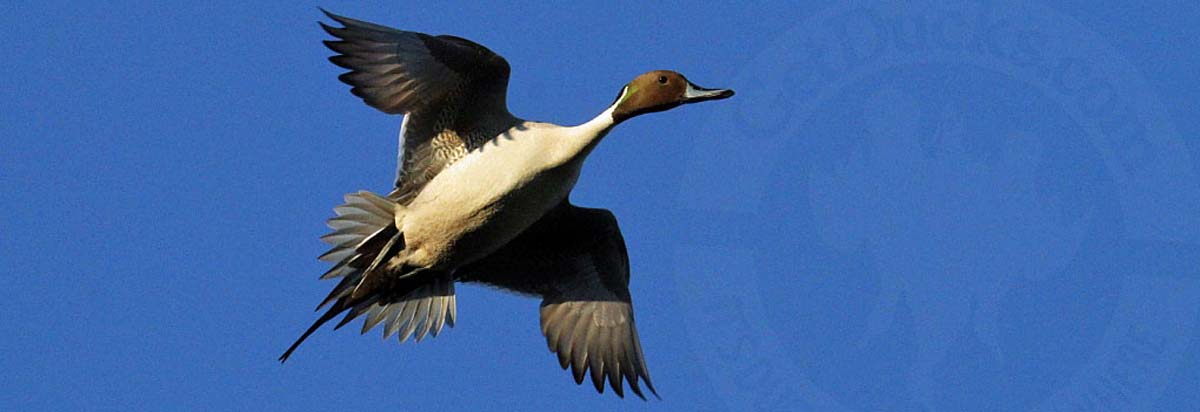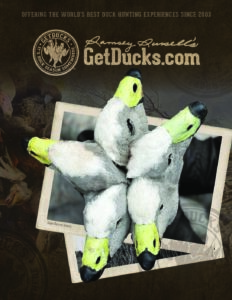Northern Pintail
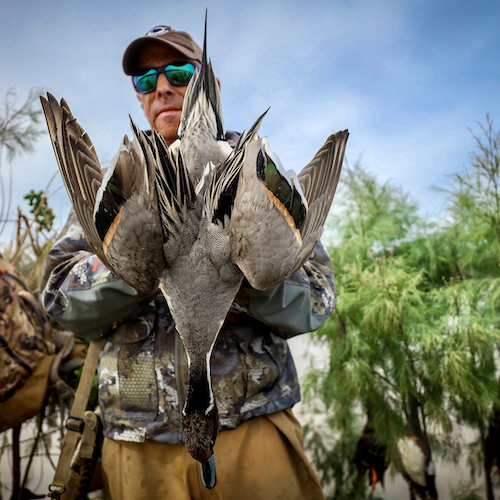
Northern Pintail (Anas acuta) namesake derives from long, streaming sprigs on the drake, that highly visible in flight and displayed high while swimming. Northern oxtail are colloquially referred to as “sprigs.” There are several pintail species worldwide, but none other rival the northern pintails impressive sprig length. Other important attributes for northern pintails are their elegant, long necks, narrow wings. Drakes have deep chocolate-colored feathers from the head extending to the throat, and down the back of the neck, with prominent white breast plumage which curls elegantly up behind the eyes. Their back appears silver, with long brushstrokes of black feathers intermixed. The drake pintail’s flashy, metallic green speculum separates from gray-brown upper wing by a creamy upper secondary coverts line. Elongated, pointed scapulars and tertials gray with black central stripes lay dramatically over the drake pintail’s back. Both sexes of this species have light blueish-gray bills with matching gray-blue legs, although some hens have darker bills.
Available Hunts
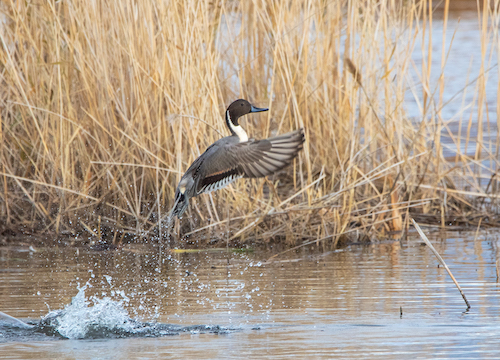
Northern pintail are found throughout the northern hemisphere to include in Europe, the Middle East, India, Asia and, of course, North America. This species tends to breed in the Northwestern United States, all of Canada, and Alaska. As many as one-third The North American continental population may breed in Alaska when the prairie pothole region is dry. Mating begins when the ice thaws, commonly occurs within seasonal wetlands, grasslands, open areas with short vegetation, and crop fields. It’s thought that their nesting in residual crop stubble has resulted in the loss of millions of eggs that may limit pintail productivity. Pintails will migrate during the night and have been recorded to fly roughly 48 miles/hour. They will reach their preferred wintering grounds covering the entire the bottom half of the United States, down into the majority of Mexico.
The favored diet of these medium-sized dabblers consists of invertebrates, crustaceans, plant material, crop fields containing rice, wheat, corn, and barley. This species will often be found among other puddle ducks to include mallards, northern shovelers, and American coots.
The U.S. Fish and Wildlife Service and Canadian Wildlife Service’s annual waterfowl report showed that both the Northern Pintail populations from 2018 to 2019 and the Long-Term Abundance show decreasing percentages, despite being a common bird. From 2018 to 2019 the species has decreased by 4%. The Long-Term Abundance has decreased by 42%.
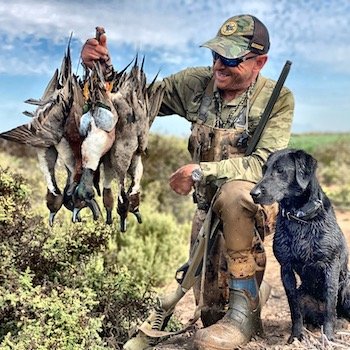
For about 30 years, American hunters have abided restrictive, federally prescribed bag limits but numbers have not rebounded greatly. It has been proposed recently that far too many drake pintails may be adversely affecting hen productivity, and further proposed that bag limit be adjusted to increase harvest of drake pintails. Northern pintail bag limits are a source of contention in the Lower-48 US, where the limit has recently been only 1 daily. Reflecting hunter-harvest distributions, daily northern pintail limits vary among Alaska (8-10), prairie Canada (4-8), and Mexico (15).
PINTAIL PROBLEMS. Elegant flight trajectories with long necks, chocolate heads pinstriped, dagger-like sprigs trailing, incessant trill-calls. Always seem to become hyper-focused when they’re in play. Beautiful prize on the strap. Distributed throughout the northern hemisphere, have taken them throughout North America flyways, from Atlantic to Pacific oceans, from dry field sets among 3 prairie Canadian provinces to Mexico’s vibrant estuaries; internationally abroad in such far flung countries as Pakistan, Mongolia, and Azerbaijan. Decades ago while working for USDA came the phone call (to our office I’ll never know why) of a band recovered in the central Mississippi Delta, near Ruleville, that had been banded in Japan. Limits vary: 8-10 in Alaska, from 4 to now 8 in Canada, ONLY ONE in the Lower 48, 15 in Mexico, where breathtaking clouds numbering of 100s fog over blinds some days.
Throughout Eurasia, there are no waterfowl bag limits. But it’s not hunter-harvest that imperils pintail populations. Instead, it’s their instinctive fidelity for nesting in residual stands of no-till crops resembling short-grass prairie in which they evolved. Even if pintail hens escape farm implements, millions of eggs do not. Been discussed in scientific literature since the 1970s. And there may be other factors. A recent guest on our Duck Season Somewhere podcast, Chris Nicolai of Delta Waterfowl, indicated that there may be so many drakes as to inhibit hen productivity, saying that after 30 years of restrictive harvest management that the data allows for a 3-pintail (no more than 1 hen) bag limit throughout the Lower 48. Listen to that episode yourself for full explanation. Where pintails are bread-and-butter ducks, it’s takes a special commitment to hunt for only one bird. Have heard that clubs in some areas ceased managing for pintail, dedicating that wintering habitat to other species. At a time when we need more hunting participants than ever before, rethinking pintail management is a very good thing.

